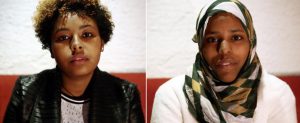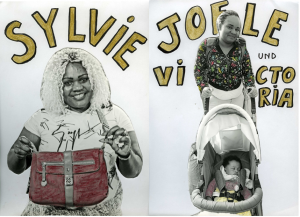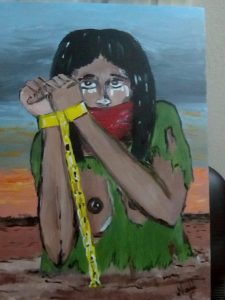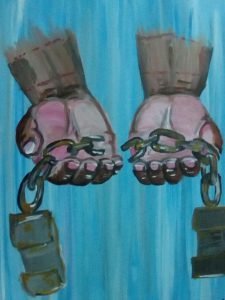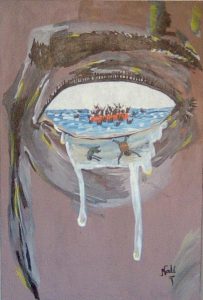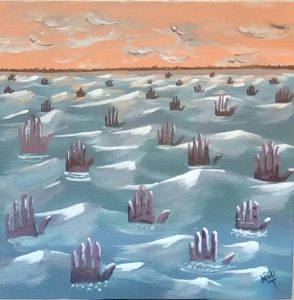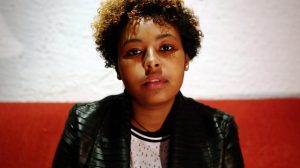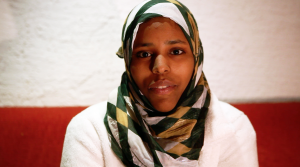Alarm Phone 6 Week Report, 5 February – 18 March 2018
Stories and Struggles of Migrant Women at Sea +++ 458 Deaths at Sea in 2018 +++ Developments in the Central Mediterranean, Western Mediterranean, and Aegean Sea +++ Summaries of 25 Alarm Phone distress cases
INTRODUCTION
In April 2017, Sylvie and Joelle wanted to cross the sea to escape their predicament and start a new life in Europe.[1] They did not know one another until they boarded the small rubber boat in Turkey, together with twenty-two others, including two children. Sylvie was anxious and entered last, handing over her red bag to Joelle who promised to return it after their safe arrival. They departed, but at some point, somewhere in the Aegean Sea, they ran out of fuel and could not continue. Sylvie tried to call for help, but her phone was caught by a large wave. Lost at sea, Joelle, who was in the 8th month pregnant, started to cry and pray for help, but nobody came. The boat capsized, and everybody fell into the water, drifting away from each other. Sylvie and Joelle were separated but Joelle did not give up: “I had a strong feeling of power in me. I don’t even know where this came from, where we fell in the sea there was nothing, no boats, no fishermen, no police, no one.” She was able to stay together with two others, Guilaine and Teddy. They floated in the water throughout the night, trying to stay conscious and together. But at some point, a wave parted them, and Joelle was all alone. Hours later, she suddenly saw a boat approaching. She was taken aboard of the rescue vessel of the NGO Proactiva and brought to land.
When they lost each other, Sylvie was able to stay together with three others, holding hands, talking, giving each other hope and trying to stay awake. But after a while they also lost one another, and when Sylvie was finally discovered, she could not see anymore: “The sea salt had burned my eyes. I was blind.” She was brought to Joelle and together they went to the hospital. Joelle asked: “Where are the others? Let’s hope they bring them even if they are not alive. But no one could join us. The same evening I saw an assistant and a psychologist and I asked them: ‘Where are my brothers and sisters?’” Eventually, they were informed that only the two of them had survived. Two out of a group of twenty-two. Joelle still had the red bag with her and returned it to Sylvie: “I thought maybe she has her money inside, I can’t abandon the bag.” Joelle said that without the SAR NGO, they would not have survived. She gave birth a few weeks later to a healthy girl: “She is my joy and my power, I believe I would have died if she was not in me. God really pitied me. It’s really a miracle. I call her Victoria-Miracle.”
Stories of women struggling across sea borders are rarely heard. When we do hear them, women are often simply portrayed as subordinate, exploited, and passive victims who depend on male companions, and who lack individual migration projects and political agency. The erasure of their agency and voices is also the effect of hegemonic narratives of migration to Europe, in which ‘the migrant’ is routinely imagined as young, able-bodied, and male, more an abstract figure than a human being, commonly constructed as a dangerous subject against whom border enforcement and deterrence policies are legitimised. Knowing well that the personal is political, and the political is personal, we want to listen to women’s voices and stories, and be inspired by their disobedient movements, their strength, their resistance. This report is published shortly after the International Women’s Day, on which women led demonstrations all over the world, including in Spain where the first nationwide ‘feminist strike’ took place against sexual discrimination, domestic violence and the wage gap, or in Turkey where the crowd of protestors shouted: “We won’t shut up, we are not afraid, we won’t obey”.[2]
The European border regime is also a gendered regime. It creates hierarchies of mobility, making it impossible for many women to leave their places of predicament in the first place. If they are able to leave, they make particularly gendered experiences, and unfortunately, many are exposed to systemic forms of gender-based violence. The increasing securitisation of borders and the criminalisation of migration are the main factors contributing to ever-more risky journeys, and the need to find professional help in overcoming border obstacles. Given the ever-lengthier and costlier journeys, exploitative situations are common, and ‘consensual’ movement can quickly turn into ‘non-consensual’, or forced, movement. At the same time, the dominant binary understanding of ‘voluntary’ or ‘forced’ migration, even inscribed in international refugee conventions, cannot do justice to the complexity of migrant experiences and journeys, and certainly not to their gendered dimension.
When women cross the sea, they often have different experiences than men and are exposed to greater danger, due to a range of factors. Proportionally, more women than men drown when trying to cross a body of water. In the Central Mediterranean, they are often seated in the middle of rubber boats, intended to keep them as far as possible from the water and thereby ‘safe’. However, it is in the middle of the boats where sea water and fuel gather the most, creating a toxic mixture that burns their skin and often causes grave injuries. There they are also most at risk of being trampled and suffocated when panic breaks out on board. In some of the larger wooden boats, women often sit in the vessel’s hold, where suffocation due to the accumulation of dangerous fumes occurs more quickly, and where, in situations of capsizing, escaping is more difficult. Many women wear longer and heavier clothes than men, making it more difficult to stay above water when they have fallen into the sea, and it has been reported that women leaving from Libya have often insufficient swimming skills. Some women are pregnant, which increases the risk of dehydration, or they hold the responsibility to care for young children that travel with them. And, of course, they are also exposed to patriarchal forms of violence, during their entire journeys, including on the boats.
In the first weeks of 2018, up until mid-March, women composed about 13 percent of travellers through the Mediterranean Sea. In the Aegean Sea, we see the most diverse composition of groups in terms of gender, with women making up 22 percent of those crossing into Greece (but also in terms of age, with children making up 37 percent here). In the Central Mediterranean, the number is about half that, women making up about 11 percent (around 15 percent children). In the Western Mediterranean, we have the lowest number of women crossing, with about 8 percent women (12.6 percent children).[3] While the Harraga border crossers from Tunisia are still predominantly male, we have seen more young women take to the boats over the second half of 2017 than ever before. Given the lack of data, we cannot say how many of the 458 deaths at sea this year were women.
Throughout their entire migratory trajectories, women are affected disproportionately by violence. Especially the women we have spoken to and who have fled from Libya tell of unimaginable suffering prior to their departure. The NGO SOS MEDITERRANEE has rescued more than 4,000 women onto their rescue vessel over two years, and they report that the number of pregnant women has doubled in their second year of operation, to 10,6% in 2017.[4] Many carry children that have resulted from rape.[5] Given these atrocities that women are subjected to, their portrayal as victims may seem unsurprising. And yet, what tends to fall out of sight through the constant repetition of such narrative are the moments of survival, political agency, and resistance that demonstrate migrant women’s tenacity and the ways in which they transform themselves, others, and the spaces they pass through on their journeys.
In our work, we have encountered countless women who have led the struggle against borders, containment, deterrence, and the separation of families and communities. During the ‘long summer of migration’, the gender composition of travellers changed – we witnessed the feminisation of migration. The reasons for the change in composition at the time were manifold, but some of the main reasons were certainly the continuously devastating situation in Syria and the escalation of conflicts in Iraq. Many simply could not remain any longer in warzones and had to leave, often to follow the men who had left months, or years before, hoping to bring their families over, once they had survived their dangerous journeys. For many, the hope to use legal routes to travel safely to Europe – either alone or with other family members – vanished when EU member states created even more restrictions on family reunification schemes, and more and more of the few legal pathways were closed down. Moreover, for those living in exile in neighbouring countries of conflict-ridden places such as Syria, Iraq and Afghanistan, the living conditions deteriorated over time, and with more and more people crossing over into Europe in 2015, they also took their chances. While before there had been boats in the Aegean Sea exclusively with male travellers on board, suddenly, there were boats where men were in the minority, and women as well as children in the majority.
Safinaz was one of them. She called us from the sea in September 2015 and stayed in touch after she had survived the crossing into Greece, so that we could follow her movements throughout Europe, via the Balkan Route, and eventually into Germany, where we met her in 2017.[6]
She was part of the migratory movements of 2015 that would lead to a historic, if temporary, collapse of the EU border regime. Those survivors of sea crossings marched on through the Balkans and there we saw women in the front rows, not only due to the tactical rationale that security forces may feel greater restraint to use violence against them, but also simply because they were strong and courageous, and willing to face-off European borderguards who stood in their paths.
It is time to listen to the voices and stories of migrant women, who are always underrepresented and overlooked. We continue to voice our solidarity with them, with those unable to escape, those on the move, and those who, after arrival, still face extreme forms of violence, such as the over 100 women at the Yarl’s Wood detention centre in the UK who have gone on hunger-strike, calling for dignified treatment and the end of detention.[7]
DEVELOPMENTS IN THE CENTRAL MEDITERRANEAN SEA
We met Viviane in Tunis at the Alarm Phone conference ‘Mediterranean Migration Movements: Realities and Challenges’ that took place in September 2017. Viviane came from the Ivory Coast to Tunisia through some professional agents who sent her and other women into the households of wealthy people where they faced not ‘only’ exploitative working conditions but where they were also mistreated and sexually abused. Their wages were often withheld, and as ‘illegals’ in Tunis they could rarely fight openly for their rights. Often, their agents would keep their passports, so that they could not even return to their countries of origin. Many were confined in the houses where they worked and when they escaped, some sought to reach Europe via Libya. In Libya, many were sexually abused, mistreated, and raped, and even when they succeeded to get onto a boat, they were often intercepted and returned to Libya or Tunisia, where they would be kept in prisons.
Viviane was able to escape from her employer in Tunisia. She is trained in public health and she now supports other women who have had similar experiences, giving advice and care. Because of her engagement, she faces threats from those who make money off the exploitation of women. She lives in Tunisia and has claimed asylum with the UNHCR, which was rejected, and she is thinking about going back to the Ivory Coast. Due to her insecure (legal) situation, we cannot print her full name. At our conference in September last year, Viviane told her story in front of a large audience. She showed paintings that she had made together with her brother Nali and they agreed to have them published in this report, with their description of the images. We want to thank her for that and wish her a lot of strength to continue with her struggle.
The painting shows a young woman who is shackled with a chain of gold. She emerges from the ground and is dressed in rags. She is gagged, her eyes are anxious and full of tears. The sky in the background is threatening. This image describes bondage and the misuse of power, exerted onto victims who are oppressed by poverty.
The painting shows hands carrying a broken chain before a blue sky in the background. The broken chain symbolizes escape from bondage. However long it took, liberation is here – it is the cry of the heart to rescue the human dignity that remains after capture in conditions of modern day slavery.
The image shows an eye in which people cry for help. The eye is a sensitive organ, and when it hurts, it tears. The tears are waves, that wash the corpses ashore. The tears represent the pain of the one who sees how the souls of those migrating to Europe drown.
The image shows black hands that reach out of the sea. In the background there is the horizon and a bleak sky. The hands call out for help. Their lives get lost, and with them the immensity of problems, and nobody cares for the horrors that are experienced by those migrating clandestinely. The horizon is the witness of such dangerous endeavor, where many get lost on the torturous journey, which, for many, means no return.
We have heard uncountable stories of suffering coming out of Libya. One instance that was particularly tragic occurred in mid-February, when a truck carrying probably more than 200 migrants in its cargo container crashed. In the media the number of passengers and deaths vary, but it seems that there were more than the 23 deaths and 124 injured that were mentioned in media reports.[9] In February, Oxfam and Borderline Sicily called on Italy and the EU to “immediately end the deal with Libya and all activities aimed at returning people to Libya, including the cooperation with the Libyan coastguard”.[10] In a previous report, based on interviews conducted with survivors from Libya last August, they stated that “84 percent of them had said they had experienced degrading and inhumane treatment, extreme violence or torture in Libya. 74 percent said they had witnessed people being murdered or tortured.”[11] It is clear that the situation has not improved since.
The few who are currently succeeding to get onto boats face a system of EU-Libyan deterrence at sea. Fortunately, courageous non-governmental actors are still seeking to rescue as many as possible to Europe. On the 10th of March, the Alarm Phone was involved in a distress situation off the coast of Libya which showcases the remarkable chain of solidarity that has been created by migrant communities, activists, and NGOs. The priest Father Zerai was informed about a boat in the Central Mediterranean, carrying 106 people. He set the activist and non-governmental rescue machinery into motion, by air and by land. The non-governmental SAR aircraft Moonbird discovered the boat and the SAR vessel of Proactiva Open Arms eventually rescued the people to Italy.[12]
In mid-March, the rescue vessel Aquarius disembarked 280 people in the Sicilian port of August. They had come from over 20 different countries to Libya.[13] Other non-governmental actors, such as Jugend Rettet, are forced to stand at the side-lines and watch, due to the criminalisation campaigns they had to face. WatchTheMed researchers Charles Heller and Lorenzo Pezzani have published a new Forensic Oceanography counter-investigation, demonstrating very clearly the severely flawed accusations made against the Jugend Rettet crew of the rescue vessel Iuventa. It provides important evidence against the attempts to criminalise and de-legitimise non-governmental rescue in the Mediterranean Sea.[14]
Our Alarm Phone ‘Solidarity Messages for those in Transit’ video project will shortly release several new videos, in which survivors tell their stories and give advice for those still on their way.[15] Two of them are Samrawit from Eritrea and Fathiya, who is Somali.
Samrawit, who survived a large-scale shipwreck in May 2017 tells about her experiences at sea and gives advice also on the problem of the fingerprint. She came from Libya in May 2017 on a large three-levelled boat, carrying 903 people. They lost orientation and when they were finally discovered, the boat fell on its side and many into the water. About 200 people lost their lives that day. When Samrawit arrived in Sicily, she was tricked into giving her fingerprints. Without shelter and support, she decided to move to Germany. She joined the group ‘Lampedusa in Hanau’ where she collectively struggled against the Dublin deportation regime.[16]
Fathiya was also rescued in the Central Mediterranean after leaving from Libya, in March 2016. Fortunately, none of the 900 people on her boat lost their lives. She did not want to live in Italy but stayed in a camp for six months where they took her fingerprints. They had to leave the camp, and without anywhere to go, they lived on the street. “It was so scary. So many people were drunk in the street, and we were afraid to live there. The women never slept, we were up day and night because we were afraid. I had a friend in another European country. She told me to go to another country in Europe to start a new life.” She went to Germany and received a rejection. But she also came to ‘Lampedusa in Hanau’ and started to fight for her right to stay: “To those other people who are in a situation like me: They should not lose hope! One day we will get what we need.”
DEVELOPMENTS IN THE WESTERN MEDITERRANEAN SEA
In February 2015, Afrique-Europe-Interact opened a rest house in Rabat for women and children in transit.[17] The rest house has since created a supportive environment for women, mainly for new arrivals in Morocco. By now, 3 apartments exist, creating a space for currently about 25 women and 10 children at a time, where they can recover from the crossing of the desert and organise and plan their futures. The rest house is open to all nationalities, but mainly for women from Sub-Sahara Africa who face additional challenges in their precarious situation in Morocco, not least due to a general racist climate against black Africans. Apart from shelter, food and medical treatment, women regularly meet in literacy classes and discussion rounds. A fourth apartment serves as a library, for the education of women and children, and as a general meeting space. The literacy course and the discussion rounds serve as spaces for political empowerment, where women engage in collective reflections and critical analyses of the reasons for their precarious situation in the context of their struggles against borders.
Until mid-March, about 2,800 people have left Morocco and crossed into Spain by sea, as well as about 1,400 people by land.[18] During the past 6 weeks, we continued to witness the lethal effects of the EU border regime. The following incidents are an incomplete list of recent tragedies in the Western Mediterranean. The number of the victims of the EU border regime in 2018, until March, reaches 104 persons in the Strait alone.[19]
On the 4th of February, a boat carrying 47 travellers capsized close to Melilla. For the Western Mediterranean, this is a major shipwreck, and thus the case circulated widely in the media.[20] Public Radio International (PRI) published a report on the incident, uncovering the identities of most of the victims in order to transform this anonymous number into human stories and pay respect to the drowned. It can be accessed here.[21] So far, only 21 bodies have been found. On the 12th of February, the Spanish search and rescue organisation Salvamento Maritimo rescued 29 travellers on a nearly sunken boat, 7 nautical miles from Granada. Many of them had to be rescued out of the water. At least 5 people went missing. The survivors were brought to Motril, where some of them were hospitalised.[22] On the 3rd of March, a rubber boat, carrying four people, capsized due to the rough sea on its way to the Spanish colony Ceuta. Two of the women on board drowned during the tragedy. The third woman and one man managed to swim to the shore of Ceuta.[23]
On Sunday, 25th of February, the Alarm Phone group in Oujda had a meeting with 15 families of missing relatives at sea in order to organise and give space to share each other’s voices and testimonies. Points of discussion were the right of families to find out what happened to their relatives as well as the responsibility of the Moroccan State and the EU and the lethal migration policy.
Recently there has been an increase in Moroccan nationals embarking on the journey towards Spain. After crossing the Strait of Gibraltar and arriving to the Spanish mainland, they are, however, sometimes directly sent back to Morocco in illegal push-back operations, with no chance to claim asylum.
Frequent raids in the forests around Nador continue, with Moroccan forces destroying the camps and deporting travellers to cities further south, where they often live in precarious makeshift camps at the train stations, since they lack the means to return. With or without residence permit, Sub-Saharan Africans are at risk to be deported at any time. Also the camp at the train station in Fez is still under constant threat to be evicted by the authorities, with part of it already being destroyed.
On the 3rd of February the “marcha por la dignidad” (march for dignity) took place in Ceuta, to draw attention to the crimes committed by the Guardia Civil on the 6th of February 2014.[24] This date, where the Guardia Civil attacked a group of travellers trying to swim across the Tarajal border with rubber bullets and tear gas, resulting in the death of at least 15 people, has become a symbol of border violence, and has been marked every year with commemorations and actions in various places in Europe and Morocco. This year, the event came shortly after the judge in charge of the investigations chose to close the case on the 28th of January, without allowing witnesses to testify, despite two direct victims of the incident expressing willingness to appear in court as witnesses[25]. Apart from the murder of at least 15 travellers on the 6th of February, those travellers who managed to reach the Spanish colony were pushed back to Morocco. This practice, which the European Court of Human Rights deemed illegal last year, remains very common today when people reach Ceuta and Melilla, and has been extended to the Strait of Gibraltar.[26]
DEVELOPMENTS IN THE AEGEAN SEA
Nasimgul and her 5-year-old daughter Jasna left Afghanistan because of the war. They did not plan to come to Europe but wanted to stay with her mother in Iran. But when they arrived there, they realised that the situation was as bad as in Afghanistan and so they decided to go to Europe via Turkey. They boarded a rubber boat but it deflated, and they were just about able to return to Turkey. They tried again: “After half an hour in the sea, the weather got bad, big waves came. I was sitting near the motor holding Jasna, a wave took us, Jasna and me fell first in the sea.” They could not swim and another wave took Jasna away from her mother. “I was crying and screaming her name: Jasna, Jasna. I heard her voice answer. I don’t know what happened then.” Nasimgul heard her cousin shout that Jasna was on the boat again, but Nasimgul could not reach the boat herself and it disappeared. At some point, a large boat sailed past her. In the morning, she saw another boat, and at noon, a helicopter, but nobody saw her, even when the helicopter returned in the afternoon. Her life-vest was full of water and heavy, but when she took it off, she started to drown.
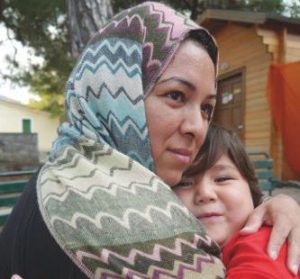 Nasimgul saw some rocks. “I talked to God and said: ‘you can bring me out with the waves. Three waves and I am out’. As soon as I said that, two waves came and threw me to the rocks. I woke up from the pain.” She climbed up the rocks and found herself on an island, and after a while, she met local residents, who helped her. She thought Jasna might have died, and when the doctor told her that she was alive, she did not believe him. “When I went in the hospital corridor and saw Jasna sitting on a chair I was so happy that I was crying. … I should never forget this story, I should not believe that I came out from the sea after 18 hours in the waves, not knowing how to swim on my own. Now I am so happy. When I arrived, I met the best people in the world, I will never forget you all. I wish to arrive in a country where Jasna can go to school, and I wish to arrive in a country where we can get asylum and after that visit my mother who is so sick.” With W2EU activists, Nasimgul went back to where she had been washed ashore. She was able to find the house of those who had helped her. The activists write: “They opened the door and could not believe their eyes! Nasimgul, the woman who came out of the sea, was standing there with her small child smiling at them. Katerina, Panagiotis and Nasimgul fell in each other’s arms.”[27]
Nasimgul saw some rocks. “I talked to God and said: ‘you can bring me out with the waves. Three waves and I am out’. As soon as I said that, two waves came and threw me to the rocks. I woke up from the pain.” She climbed up the rocks and found herself on an island, and after a while, she met local residents, who helped her. She thought Jasna might have died, and when the doctor told her that she was alive, she did not believe him. “When I went in the hospital corridor and saw Jasna sitting on a chair I was so happy that I was crying. … I should never forget this story, I should not believe that I came out from the sea after 18 hours in the waves, not knowing how to swim on my own. Now I am so happy. When I arrived, I met the best people in the world, I will never forget you all. I wish to arrive in a country where Jasna can go to school, and I wish to arrive in a country where we can get asylum and after that visit my mother who is so sick.” With W2EU activists, Nasimgul went back to where she had been washed ashore. She was able to find the house of those who had helped her. The activists write: “They opened the door and could not believe their eyes! Nasimgul, the woman who came out of the sea, was standing there with her small child smiling at them. Katerina, Panagiotis and Nasimgul fell in each other’s arms.”[27]
So far in 2018, about 3,500 people have arrived on the Greek islands. With 1,633 arrivals in January and 1,256 in February, the number of people succeeding to cross has risen in comparison with 2017, when 1,393 arrived in January and 1,089 in February. Until the 18th of March, 1,230 people have made it. When they arrive on the islands, they face inhumane and overcrowded conditions in Europe’s ‘reception’ hotspot centres.[28] Women in particular are forced into unbearable situations, often experiencing sexual violence in these places of confinement.
Others, who know well of these conditions, have decided to take different routes. In mid-February, the boat of a group of eight capsized in the Maritsa River, in northern Greece. Three people drowned and the five others went missing. The dead were identified as Ayşe Abdurrezzak and her children Abdulkadir (11) and Halil (3). Ayşe and her husband, who is among the missing, were teachers in Turkey but decided to escape after being dismissed from their jobs in Turkey’s post-coup crackdown.[29] They have escaped a place and regime that Europe considers safe enough to deport people back to, a country that commits massive atrocities against Kurds in Afrin and elsewhere, and that indiscriminately shoots at people trying to escape the war in Syria and summarily returns Syrian asylum seekers to a warzone. As Human Rights Watch recently stated: “Syrians fleeing to the Turkish border seeking safety and asylum are being forced back with bullets and abuse.”[30]
SUMMARIES OF ALARM PHONE DISTRESS CASES
Central Mediterranean
On Saturday the 3rd of March, at 10.43pm, the Alarm Phone shift team was alerted by Father Mussie Zerai to a boat in distress, carrying 92 travellers, forwarding us their phone number along with the number of a contact person in Libya. The travellers had left from Zawiya, Libya, the night before at 02am. We reached the contact person in Libya, who had just spoken to the travellers, and told us that their situation wasn’t good, but that they were, however, still able to move forwards. At 11.43pm we called the Italian coast guard. An hour later we spoke with the coast guard again, who thought they had localised the travellers close to El Bouri oil platform. At 2.42am we managed to establish direct contact to the travellers. At 3.40 we called the travellers again. This time they told us that they could see “dry land” where they could disembark. Through the Italian coast guard we learned that the travellers had disembarked, and were approaching a village. After this it was no longer possible to reach the travellers. At 10.12am we spoke to the contact person again, who informed us that the travellers had now been found by the Libyan police on an island off Zuwarah. We later figured out that they must have arrived to the peninsula Farwa in the state of Zuwarah (For full report, see: http://www.watchthemed.net/reports/view/792).
On Saturday, the 10th of March 2018, our Alarm Phone shift team was alerted at 1.01pm by Father Zerai to a boat in distress off the coast of Libya. We received a phone number of one of the travellers and their GPS location. Despite several attempts, we were unable to reach them directly. However, we were able to recharge their Thuraya satellite phone with credit, so that they could still make emergency calls. We then informed the Moonbird SAR aircraft about the case and they promised to look for the boat. We also spoke to the SAR vessel of Proactiva Open Arms which was closest to the position of the boat in distress. They confirmed that they had already learned about the situation and were on their way. They said that there were 106 people on board. At 2.53pm, Moonbird confirmed the discovery of the vessel at a slightly different location. At that point in time, Open Arms was about 2 hours away from the location. At 4.19pm, Moonbird confirmed that a SAR operation had been launched by Open Arms (see: http://watchthemed.net/reports/view/795).
On Sunday the 11th of March 2018, our Alarm Phone shift team received a message from Father Zerai at around 10am, informing us about a boat that had left from Al Khums/Libya, carrying about 90 people, the majority from Eritrea. We could not reach the travellers directly but were able to re-charge their satellite phone with credit. We contacted the Italian Maritime Rescue Coordination Centre (MRCC) in Rome who had been informed about this case already. We also informed the non-governmental SAR aircraft Moonbird. At 11.35am Moonbird informed us that they were trying to locate the boat in question. The NGO Proactiva Open Arms then informed us at 12.20pm that they had rescued a group of people similar to the one we had described to them earlier. They stated that they had rescued 93 people who had come from Al-Khums the night before, all from Eritrea except one person who had come from Sudan. The group was in a very bad and weak medical condition, and the rescue vessel was heading north at a maximum speed to evacuate them (see: http://watchthemed.net/reports/view/796).
On Thursday, the 15th of March 2018 at 3.39pm, Father Mussie Zerai alerted the Alarm Phone to two boats in distress in the Central Mediterranean Sea. He forwarded their GPS positions and their satellite phone numbers and we immediately tried to call them, but without success. One hour later, he also informed us about a third boat, which was travelling in the same area. We recharged their satellite phone’s credit at 5.05pm and again at 5.28pm. In the following hours, we continued trying to reach the travellers and monitored their phones’ credit. In the meantime, we learned that the Spanish rescue organization Proactiva Open Arms was active in the region and was under attack from Libyan coastguard units. At 6pm, we called the Italian Maritime Rescue Coordination Centre (MRCC) in Rome and forwarded all information to them, we had received so far. Afterwards, we reached out to Proactiva Open Arms and learned from them that they had rescued 218 people in distress in the area, probably including the two boats Father Mussie Zerai had initially informed us about. At 0.41am of the next day, the MRCC confirmed to us that all boats in distress in this area had been rescued, yet without detailed information on specific cases (see: http://watchthemed.net/reports/view/808).
Western Mediterranean
On Friday, the 16th of February 2018 at 4.55pm, contact persons informed the Alarm Phone about a boat in distress in the Western Mediterranean Sea with 34 persons on board, including 7 women and 3 children. They provided us with the travellers’ phone number and we tried to call the boat at 4.57pm but did not reach it. At 5.22pm, we called the Spanish rescue organization Salvamento Maritimo (S.M.) in Alméria, who confirmed to us that the phone with the given phone number had been rescued and brought to Mortil/Spain (see: http://watchthemed.net/reports/view/803).
On Sunday, the 18th of February 2018 at 4.17am, the Alarm Phone was directly called from a Moroccan number, informing us about two persons who had left from a beach near Tangier/Morocco and were still on the water. At 4.37am, we alerted the Spanish rescue organization Salvamento Maritimo (S.M.), who was already searching for the travellers with a rescue vessel. At 5.05am, the contact person told us that the travellers were in severe distress and asked us to call the Moroccan Marine Royale. At 5.08am, the Marine Royale confirmed to us that they were also searching for the travellers in distress. At 5.32am, the contact person called us again and informed us that the two travellers have been rescued by the Moroccan Marine Royale (see: http://watchthemed.net/reports/view/804).
Also on Sunday, the 18th of February 2018 at 8.12am, a contact person alerted the Alarm Phone to a boat in distress in the Western Mediterranean Sea, with 9 people on board, including one woman. They had left from Tangier/Morocco at around 4.30am. He forwarded their phone number to us and we immediately tried to call them, but without success. However, at 8.56am, he informed us that the travellers had been intercepted by the Moroccan Marine Royale (see: http://watchthemed.net/reports/view/805).
On Tuesday, the 20th of February, at 10:30am, we were alerted to a boat in distress carrying 33 people. The boat had left towards Spain from around Nador at 5:30am CET. We couldn’t establish a direct connection to the boat. At 10:53am we called the Spanish rescue authority Salvamento Maritimo in Almería and informed them about the boat. At 11:09am we reached the travellers. The people on board reported about water entering the boat. At 11:53 we called Salvamento Maritimo again, but there were no news on the SAR progress. At 12:40am the contact person informed us that the situation on board was getting more severe. At 12:50am we called Salvamento in Almería again to emphasize the urgency of the SAR operation. At 03:15 we called Salvamento Maritimo in Almeria that informed us that a boat carrying 33 persons had been intercepted by the Moroccan Marine Royale. Our contacts in Morocco confirmed that the travellers had been brought to the police and then pushed-back further to the south (see full report here: http://watchthemed.net/reports/view/785).
On Wednesday, the 14th of March 2018 at 6.41am, a contact person alerted us to a boat in distress in the Western Med, with 10 people on board. We immediately tried to get in touch with them, but without success. We called the Spanish rescue organization Salvamento Maritimo (S.M.) at 7.35am, who told us that they were already searching for the boat. Yet, at 7.38am, the contact person told us that the boat had been intercepted by the Moroccan Marine Royale in the meantime. At 7.55am, we learned from the contact person that one person went missing during the rescue operation of the Moroccan Marine Royale (see: http://watchthemed.net/reports/view/806).
Also on Wednesday, the 14th of March 2018, at 6.59am, a contact person alerted the Alarm Phone to a boat in distress in the Western Mediterranean Sea, with 9 people on board. They had left from Tangier/Morocco at around 3am. At 7.35am we called the Spanish rescue organization Salvamento Maritimo (S.M.), who told us that they were already informed about the boat in distress and were searching for it. At 7.45am, we called S.M. again and they confirmed to us that they had rescued the boat and would bring the travellers to Tarifa/Spain (see: http://watchthemed.net/reports/view/807).
Aegean Sea
On Saturday the 10th of February 2018, at 1.12am, our Alarm Phone shift team was alerted by a contact person to a boat in Turkish waters, carrying 10 people. Their engine stopped and we received their GPS coordinates. We informed the Turkish coastguards about the situation. At 1.36am, we received an update from our contact person, the boat had been found and the people rescued. At 1.52am, the Turkish coastguards confirmed that they had rescued the boat (see: http://watchthemed.net/reports/view/784).
On Tuesday, the 13th of February 2018 at 5.12am, a contact person alerted the Alarm Phone to a boat in distress with 50 travellers on board, whose engine had stopped near the Greek island of Kos. We tried to call them and informed the Greek coastguard in Piraeus, who already knew about the boat. At 5.54am, the travellers directly sent us a voice message, informing us that the rescue vessel had took them in tow, bringing them to the port of the Greek island of Kos. At about 7pm, they informed us that all travellers have been rescued (see: http://watchthemed.net/reports/view/798).
On Wednesday, the 21st of February, at 6:34am, we received information about a boat in distress on its way to Mytilene/Lesvos, carrying around 50 people, among them 20 children. We couldn’t establish direct contact with the boat. At 7:26am we called the Greek Coast Guard to pass the information. At 08:21 the Coast Guard confirmed the rescue of all 48 people to Lesvos (see: http://watchthemed.net/reports/view/786).
On Wednesday, the 21st of February, at 8:41am, we were alerted to a boat in distress moving towards Samos, carrying 37 people. The contact person also sent the position of the boat. At 08:52am, we called the Greek Coast Guard in Piraeus and passed the information. We couldn’t establish connection to the boat. At 11:58am the contact person passed us a second number on board, but both numbers remained unavailable. At 12:45am friends on Samos confirmed that a boat carrying 40 people (26 male, 8 female and 6 children) had been rescued in the morning. At 3:58pm the contact person confirmed the rescue (see: http://watchthemed.net/reports/view/787).
On Thursday, the 22nd of February, at 05:54am, we were alerted to a boat in distress in the north of Samos island with 39 people on board. We tried to establish a connection to the boat. At 9:00am we called both the Coast Guard in Piraeus and the Samos Port Police to pass the information. At 10:05am we managed to reach local friends who confirmed the rescue of two boats to Samos that morning, but couldn’t identify them further. At 8:24pm our contact person confirmed their safe arrival on Samos (see full report here: http://watchthemed.net/index.php/reports/view/794 ).
On Wednesday the 28th of February, at 0.52, the Alarm Phone shift team was alerted by a contact person to a group of 40 travellers, amongst them 19 children, forwarding us their position and phone number. We managed to reach the travellers straight away, and they confirmed that they were in urgent distress. At 1.06am we called the Greek coast guard and passed on the information we had. Afterwards we contacted different solidarity organisations on the ground. At 2.42am one of these informed us that the travellers had reached Palios, and that they were all safe (see: http://www.watchthemed.net/index.php/reports/view/788).
On Friday the 2nd of March, at 0.06am, we were alerted by a contact person to a group of 45 travellers including a pregnant woman, forwarding us their phone number, and a position showing that they were north of the Greek island Lesvos. We were not able to establish direct contact to the boat. At 0.18am we called the Greek coast guard and passed on the information we had. We also passed on this information to solidarity groups in the area afterwards. At 0.51am one of the solidarity groups informed us that the Greek coast guard was carrying out the rescue operation, and when we called the coast guard at 1.04am, they confirmed that the travellers had been rescued (see: http://www.watchthemed.net/reports/view/789).
On Friday the 2nd of March, at 0.57am, the Alarm Phone shift team was alerted by a contact person to a group of 38 travellers, amongst them 14 children and one pregnant woman, forwarding us their phone number and a position showing that they were close to the Greek island Samos. We were not able to establish direct contact to the travellers. At 1.04am we called the Greek coast guard and passed on the information we had about the boat. At 1.27am the contact person informed us that the travellers had been rescued by the Greek coast guard, which the coast guard confirmed when we called them afterwards (see: http://www.watchthemed.net/reports/view/790).
On Friday the 2nd of March, at 6.51am, the Alarm Phone shift team was alerted by a contact person to a group of 30 travellers, amongst them 16 children, forwarding us their position and phone number. We called the Greek coast guard and forwarded the information we had. At 7.18am we called the coast guard again, and they informed us that they were in the process of carrying out the rescue operation. Later we got a confirmation from the contact person that the travellers had been rescued and brought to Leros (see: http://www.watchthemed.net/reports/view/791).
On Monday the 5th of March 2018, at 6.38am, a contact person informed our Alarm Phone shift team about a boat in distress, carrying 45 people. We received a GPS position as well as the phone number of one of the travellers. They were on their way to Lesvos, but their engine had stopped working. We spoke to the boat-people at 6.44am – they were ok but could not re-start the engine. They said that there were 10 children among them and we later found out that there were also 6 women, among them one pregnant woman. At 6.54am, they sent a new position, showing them still in Turkish waters. We explained that to them a few minutes later. At 7.23am, a contact person informed us that the Turkish coastguards had found the boat, and at 7.36am he told us that they had been rescued by the Turkish coastguards, to be returned to Turkey (see: http://watchthemed.net/reports/view/793).
On Monday the 12th of March 2018, we were informed at 3.52am by a contact person to a boat in distress in the Aegean Sea. We received a GPS position, a mobile phone number, as well as the information that there were 36 people on the boat, including 11 children. The boat’s engine had stopped working. We could see on our maps that they had already reached Greek water and were south of Lesvos Island. We were able to speak to the travellers at 4.06am and though we could not hear them properly, we could make out that they were calling for help. At 4.08am, we contacted the Greek coastguards and forwarded the position of the boat – they promised to conduct a SAR operation. We passed this information back to the travellers. At 4.22am, the people from the boat told us via WhatsApp that they required urgent help. Our contact person told us at 4.33am that the people on the boat could see lights from Lesvos Island. At 5.08am, the Greek coastguards confirmed that they found the boat in distress and were conduction a SAR operation. At 6.22am, people on Lesvos confirmed that the boat had safely landed (see: http://watchthemed.net/reports/view/797).
On Thursday, the 15th of March 2018 at 2am, a contact person informed us about a boat in distress south of the Greek island of Lesvos, with approximately 65 people on board, including 25 children. The travellers asked us to alert the Turkish coastguard, which we did at 2.35am. At 3.25am, the coastguard called us back and informed us that they had search in the area with a rescue vessel but had not found any boat in distress. However, at 6am, a contact person informed us that the travellers had safely arrived at the Greek island of Lesvos (see: http://watchthemed.net/reports/view/799).
Also on Thursday, the 15th of March 2018, at 7am, a contact person informed the Alarm Phone about a boat in distress south of the Greek island of Kos, with 36 people on board, facing very high waves. At 7.32am, we briefly reached them via phone, and at 7.42am, the contact person forwarded two photos to us, indicating that the travellers had already been transferred to a rescue vessel. Rescue was finally confirmed at 2.12pm (see: http://watchthemed.net/reports/view/800).
On Friday, the 16th of March 2018 at 3.41am, a contact person informed the Alarm Phone about a boat in distress east of the Greek island of Lesvos, with 55 people on board, including 25 women and 20 children. We alerted the Greek coastguard, 4am and were told that the coastguard on Lesvos will look for the boat in distress. At 4.43am, the coastguard called us back, informing us that they had found and rescued the boat (see: http://watchthemed.net/reports/view/801).
Also on Friday, the 16th of March 2018, at 5am, a contact person informed the Alarm Phone about a boat heading towards the Greek island of Agathonisi, with 19 people on board, including 10 women and 4 children. We alerted the Greek coastguard at 5.16am, who sent a rescue vessel to the area to search for the boat in distress. However, at 5.57am, the contact person informed us that the travellers had safely arrived on the Greek island of Agathonisi on their own (see: http://watchthemed.net/reports/view/802).
Footnotes
[1] Great thanks to Alarm Phone member Marily for supporting Sylvie and Joelle, for writing down their stories, and showing them at an exhibition in Hamburg. She gave us the permission to re-print the images. You can find the full story here: http://infomobile.w2eu.net/2018/03/14/sylvie-and-joelle-the-only-survivors-of-the-shipwreck-of-24-april-2017-between-turkey-and-greece/. We also want to mention that it was due to the solidarity of volunteers and activists that Sylvie, Joelle and Victoria found support after surviving their horrible journey – thanks to Refugee Rescue Mo Chara, Sea-Watch and Noborder kitchen!
[2] https://www.transnational-strike.info/2018/03/01/pdf-tss-journal-power-upside-down-womens-global-strike/, http://hacialahuelgafeminista.org/, https://www.theguardian.com/world/2018/mar/08/spanish-women-give-up-work-for-a-day-in-first-feminist-strike, https://www.al-monitor.com/pulse/originals/2018/03/turkey-women-take-to-streets-demand-equality.html
[3] http://data2.unhcr.org/en/situations/mediterranean
[4] http://www.rfi.fr/afrique/20180308-femmes-refugiees-tres-souvent-victimes-agressions-sexuelles-lors-voyage?ref=fb
[5] http://sosmediterranee.org/wp-content/uploads/2018/03/SOS-MED_Pressedossier_Frauen_auf_der_Flucht.pdf?utm_source=Newsletter+%28deutsch%29&utm_campaign=1b50d27270-EMAIL_CAMPAIGN_2017_10_28&utm_medium=email&utm_term=0_d005ee7a12-1b50d27270-170845573
[6] https://alarmphone.org/en/2017/12/03/the-story-of-safinaz-berta-and-maurice-stierl/?post_type_release_type=post
[7] https://detainedvoices.com/2018/02/22/the-hunger-strikers-demands/, https://soasdetaineesupport.wordpress.com/2018/02/26/4-things-you-can-do-to-support-the-yarls-wood-strikers/
[8] https://www.afp.com/en/news/826/eu-says-16000-migrants-cleared-libya-camps-doc-12g8ox1
[9] http://www.aljazeera.com/news/2018/02/23-killed-truck-carrying-migrants-overturns-libya-180214152726477.html
[10] https://www.oxfam.org/en/pressroom/pressreleases/2018-02-01/one-year-libya-migration-deal-people-still-captivity-and
[11] Ibid.
[12] http://watchthemed.net/reports/view/795
[13] https://twitter.com/sosmedgermany?lang=de
[14] https://blamingtherescuers.org/iuventa
[15] https://www.youtube.com/channel/UC8euh2Zh5e_PHnovsiUiCBQ/videos?disable_polymer=1
[16] http://lampedusa-in-hanau.antira.info/
[17] https://afrique-europe-interact.net/1336-0-Rasthaus-ABC.html
[18] http://data2.unhcr.org/en/situations/mediterranean/location/5226
[19]https://www.ouest-france.fr/monde/migrants/maroc-deux-femmes-se-noient-en-voulant-rejoindre-l-enclave-de-ceuta-5601134
[20]http://www.abc.es/espana/abci-encuentran-unos-20-cadaveres-inmigrantes-flotando-mar-cuatro-millas-melilla-201802040814_noticia.html, http://www.dw.com/en/at-least-20-migrants-found-drowned-near-spanish-enclave-of-melilla/a-42446644 , https://www.nytimes.com/2018/02/04/world/europe/migrant-crisis-spain-morocco.html
[21]https://www.pri.org/stories/2018-03-01/forty-seven-people-died-crossing-mediterranean-wooden-boat-earlier-month-their
[22]http://www.ansamed.info/ansamed/it/notizie/rubriche/cronaca/2018/02/12/migranti-29-salvati-a-largo-granada-almeno-5-i-dispersi_90fd880d-7a4c-484f-8ab9-1b478b1a406c.html
[23] https://elfarodeceuta.es/ellas-carmen-echarri/
[24] http://www.redesinterculturales.org/v-marcha-la-dignidad-3febrero2018-ceuta/
[25]http://www.statewatch.org/news/2018/feb/ecchr-Ceuta-pushback-prel.pdf
[26] http://www.zeit.de/politik/ausland/2017-10/eugh-verurteilt-spanien-abschiebungen-migranten
[27] You can find the whole story here: http://lesvos.w2eu.net/files/2015/10/nasimgul-14.pdf. Thanks to W2EU for allowing us to share it! Another fascinating story can be read here: http://infomobile.w2eu.net/2016/10/15/my-shoes-burned-in-moria-before-my-shoes-burned-i-used-to-run/
[28] http://www.legalcentrelesbos.org/2018/02/10/january-2018-report-on-rights-violations-and-resistance-in-lesvos/
[29] http://harekact.bordermonitoring.eu/2018/02/13/3-dead-5-missing-in-attempt-to-escape-turkeys-post-coup-crackdown/
[30] https://www.hrw.org/news/2018/02/03/turkey/syria-border-guards-shoot-block-fleeing-syrians
